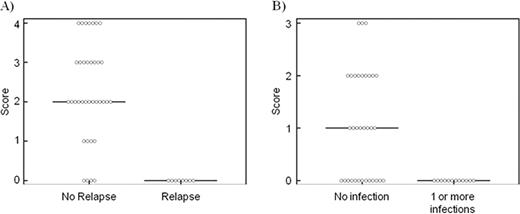Abstract
Abstract 1285
Relapse is a major cause of hematopoietic cell transplant (HCT) failure. Successful recovery of immunity against leukemia treated with HCT (GVL immunity) is important in preventing relapse. Thus, assays measuring GVL immunity could identify patients at risk of disease relapse. However, development of such assays would be impossible or impractical, as not all tumor antigens are known, and those that are known are each relevant for only a fraction of HCT recipients. There is an association between reconstitution of GVL immunity and herpesvirus specific immunity (Parkman et al, BBMT 2006). If an assay measuring immunity specific for herpesviruses present in >90% individuals (EBV, VZV, HHV6) could serve as a surrogate for GVL immunity, then this assay could be used for gauging GVL immunity in >90% HCT recipients. Possibly, such assay could also serve as a surrogate for global antimicrobial immunity (immunity against not only herpesviruses but also other viruses, bacteria and fungi). Here we evaluated multiple assays of anti-EBV/VZV/HHV6 immunity for their suitability to serve as surrogates for GVL immunity and global antimicrobial immunity.
On day 56 post-transplant, we studied 46 allo-HCT recipients for AML, who did not develop GVHD by day 56 (preemptive donor lymphocyte infusion for relapse would not be considered for patients with GVHD). Blood mononuclear cells were stimulated with viral lysate from EBV, HHV6 or VZV, or overlapping EBNA3, LMP1+2 or U54 peptides. After overnight incubation, cells were stained for CD3, CD4, CD8, IFNγ, TNFα and IL2 and analyzed by flow cytometry. Patients were followed for outcomes including relapse and definite (microbiologically documented) infections. For each specific T cell subset, absolute counts of the subset cells were compared between patients who did vs. did not relapse (or did vs. did not develop at least one infection between day 56 and 180) using Mann-Whitney test (for infections, this was done only for pre-selected subsets, ie. those that showed significant correlation with infection rates [p<0.05]). Subsets with lowest p values were combined into a scoring system, where for each subset, a score of 1 was assigned to patients that had absolute counts above a cutoff. The cutoff was defined as the mean of the highest subset count value in patients who relapsed or developed at least one infection and the nearest highest value (in patients who did not relapse or develop at least one infection).
The following subset counts showed the highest association with relapse: VZV specific CD4 T cells producing IFNγ, EBV lysate specific CD8 T cells producing IFNγ and IL2, BZLF1 specific CD4 T cells producing IL2 with IFNγ or TNFα, and BZLF1 specific T cells producing TNFα and IL2. When the scores of these 5 subsets were combined, a score of <1 was 100% sensitive and 78% specific for relapse. The following subsets showed the highest association with infections: U54 specific CD8 T cells producing TNFα, EBNA3 specific CD4 T cells producing TNFα and IL2, and EBV lysate specific CD8 T cells producing IFNγ, TNFα and IL2. The score of <1 was 100% sensitive and 36% specific for developing at least one infection between day 56 and 180. Multivariate analysis could not be performed because there were no patients with relapse or infection that had a score of 1 or higher.
Herpesvirus specific T cell counts can serve as surrogates of both GVL immunity and global antimicrobial immunity. They are highly sensitive but only moderately specific for relapse and infections.
No relevant conflicts of interest to declare.
Author notes
Asterisk with author names denotes non-ASH members.


This feature is available to Subscribers Only
Sign In or Create an Account Close Modal